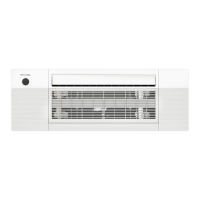
Do you have a question about the MrCool DIYCASSETTE HP-230C25 Series and is the answer not in the manual?
| Brand | MrCool |
|---|---|
| Model | DIYCASSETTE HP-230C25 Series |
| Category | Air Conditioner |
| Language | English |
Explains safety symbols and their meanings for safe operation.
Lists critical DO NOT instructions for safe operation and installation.
Details warnings and cautions for electrical work and installation.
Warnings about electrical connections, grounding, and wiring.
Precautions regarding refrigerant leaks, gases, and handling.
Warnings about proper installation, grounding, and unit handling.
Cautions on refrigerant leaks, packaging disposal, and sharp parts.
Guidelines for installation according to local and national standards.
Identifies key parts of the indoor unit like grille, filter, and outlet.
Lists and identifies components of the indoor and outdoor units.
Considerations for installing single or multi-zone systems.
Shows the layout of the indoor unit's display panel.
Explains the meaning of various codes shown on the display panel.
Lists all parts and accessories included with the unit for installation.
Lists optional parts that may be needed for installation.
Details normal operating temperature ranges for COOL, HEAT, and DRY modes.
Provides guidance for achieving optimal performance and saving energy.
Explains the functionality of different operating modes.
Describes the FAN mode where only the fan operates for air circulation.
Explains SLEEP mode for energy saving and refrigerant leak detection.
Details louver memory function and warnings about narrow angles.
Explains 3-minute protection and auto-restart after power loss.
Details the self-cleaning function and associated temperature cautions.
Instructions for lowering the air intake grille for filter access.
Guidance on installing the optional wireless control module.
Important warnings before performing any service or cleaning.
Instructions for cleaning the unit with a soft cloth and cautions.
Recommends cleaning frequency and methods for the air filter.
Steps to access the filter and warnings during removal.
Steps to prepare the unit for long periods of inactivity.
Checks to perform after prolonged non-operation.
Shows dimensions for the face plate and side view.
Provides front view dimensions and clearance requirements.
Details maximum line set length and height for 18K single-zone systems.
Lists line set lengths and height differences for multi-zone systems.
Pre-installation tasks like determining routes and unpacking.
Guidelines for choosing an appropriate location for the indoor unit.
Steps to locate ceiling joists for proper mounting.
Instructions on using the template to mark and cut the ceiling hole.
Safety warnings and tips for cutting drywall and removing debris.
Instructions for drilling a wall hole for refrigerant piping and cables.
Steps for inserting and securing the protective wall sleeve.
Instructions on how to unwind the line set to the correct length.
Specifies bend radius and warnings about repeated bending.
Steps to access the control box and feed the DIYPRO™ cable.
Details on connecting the DIYPRO™ cable wires to the circuit breaker terminals.
Guides on orienting and lifting the cassette into the ceiling hole.
Instructions on securing the cassette to ceiling joists using screws.
Lists necessary tools and crucial notes for line set installation.
Detailed steps for aligning and connecting the line set to cassette adapters.
Specifies torque values for line set connectors to prevent leaks or damage.
Method for checking piping connections for refrigerant leaks.
Steps to install the plastic tray beneath line set connections.
Instructions for attaching the drainpipe adapter to the cassette.
Rules for drainpipe slope, supports, and vertical sections.
Notes on drainpipe outlet placement and avoiding kinks or dents.
Instructions for bending the line set and sealing the wall hole.
Important note on re-insulating around the cassette after installation.
Guidelines for choosing an appropriate location for the outdoor unit.
Specifies minimum clearance around the outdoor unit for airflow.
Guidance for installation in harsh weather and salty environments.
Steps for installing the drain joint at the bottom of the unit.
Instructions for anchoring the unit to the ground or a concrete platform.
Table listing dimensions for mounting feet based on unit model.
Detailed steps for installing the unit on a wall-mounted bracket.
Tips on using rubber gaskets to reduce vibration and noise.
Steps to remove tray and guidelines for multi-zone connection order.
Instructions for aligning and connecting refrigerant pipes to outdoor unit valves.
Specifies torque values for connecting line sets to the outdoor unit.
Instructions for opening the refrigerant valves on the outdoor unit.
Method for checking refrigerant piping and valve connections for leaks.
Steps to attach and secure the cassette face panel to the indoor unit.
Steps to connect wiring and set the circuit breaker to ON.
Steps to prepare and install the wireless module into the cassette.
Warns against using non-manufacturer modules to prevent malfunction.
Lists regulations and precautions for performing electrical work.
Details voltage, circuit capacity, and grounding requirements.
When to use an air switch and illustrations of wiring configurations.
Explains the diagram and how to select the correct power cable.
Critical warning about mixing live and null wires.
Connects cables based on diagrams and lists wiring precautions.
Table for selecting power cable gauge for multi-zone units.
Wiring diagrams for multi-zone systems up to 5 zones.
Confirms electrical wiring installation and grounding.
Describes leak check methods and actions after confirming no leaks.
List of checks to perform before starting the test run.
Steps to perform the test run and post-run checks.
Steps to test the smooth flow of the drainpipe.
Instructions for performing a water discharge test to check drainage.
Lists critical warnings and common operational events.
Causes for unit not turning on and unexpected mode changes.
Explains white mist emission and different unit noises.
Discusses unit noises, odors, and outdoor fan operation.
Causes and solutions for poor cooling and heating performance.
Causes and solutions for unit not working or starting/stopping frequently.
Explains and details how to activate the automatic wiring/piping correction function.
Instructions for disposing of electrical waste and electronic equipment.
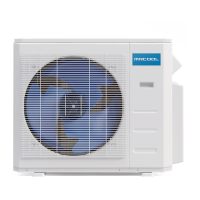



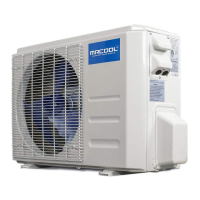
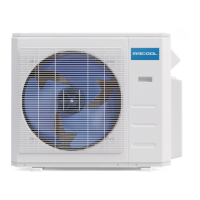


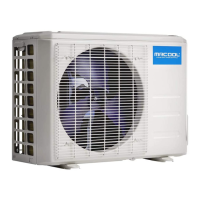
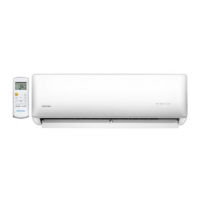
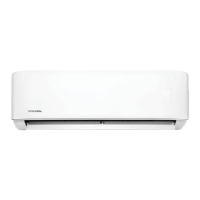
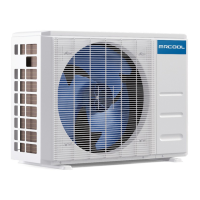
